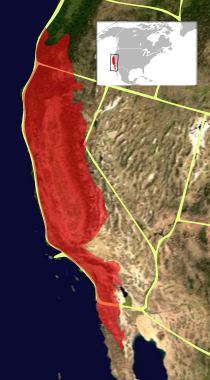Biodiversity in California
California is home to more than 5000 species of native plants. If one recognizes all of the different subspecies that exist in California, the native flora includes approximately 6500 minimum-rank taxa (species, subspecies, and varieties; Jepson eFlora, 2015). To put this in perspective, this is more than exist in any other state in the nation, and more than exist in all of Canada (Kartesz, 2015; USDA PLANTS database, 2015).

The term "native"
Although species have always migrated around the world, the rate of movement (and subsequent impacts on species already in an area) increased dramatically when Europeans began colonizing distant parts of the world. For plants, we use the same rule-of-thumb that we use for humans: a "native" group is a group that existed in a place before this rapid movement began.
Although most of the plant species and subspecies in California are native (having existed in California before the arrival of Europeans), a number of introduced or alien plant species have become naturalized and firmly established in the wild. Those that become invasive often pose threats to native species, outcompeting them for resources or changing the environment in other ways that harm them.
More than a quarter of the native plant species in California are endemic to California, existing nowhere else on Earth (Harrison 2013). Species that are endemic to a relatively small area are generally of greater conservation concern than other species: if they are extirpated (eliminated from that local area), the species is extinct. In contrast, if a widespread species is extirpated from the same small area, it still exists somewhere else on Earth. Of all the plant taxa that are native to the United States, Canada, and Greenland combined, over 5% are endemic (restricted) to Hawai'i and over 9% are endemic to California (Imada, 2012; Jepson eFlora, 2015; Kartesz, 2015; USDA PLANTS database, 2015). The California Native Plant Society maintains inventories of rare plants in California: there are currently 22 that are considered extinct or that have not been seen in the wild in at least 20 years (CNPS Rare Plant Program, 2014).
Why are there so many plant species in California? -- California spans a large range of latitudes, from the Mexican border to Oregon, and a large range of elevations, from Death Valley (the lowest point in the United States,) to Mount Whitney (the highest point outside of Alaska). There is wide variation in rainfall across the state, from an annual average of less than 3 inches per year in Death Valley to an annual average of approximately 100 inches per year in some spots along the northwest coast of California. In addition, a wide range of soil types exists in the state. The resulting environmental variation helps explain why California supports so many different types of species.
Why are so many plant species endemic to California? – Part of the reason is that much of California has a climate that is found only in a few places on Earth: a mediterranean climate.
The mediterranean climate
Most of California (but not all) has a mediterranean climate, with hot, dry summers and cool, wet winters. Annual rainfall is usually between 14 and 35 inches per year. High-elevation mountain areas may regularly receive snow during the winter, but still experience dry summers. To the east of California's major mountain chains, there are deserts. Deserts have lower rainfall (usually less than 10 inches per year), lacking the heavy winter rains that typically occur in a mediterranean climate. Potential evaporation in deserts (the amount of water that would evaporate if it were available) is higher than the rainfall received.
Only five regions on Earth have a mediterranean climate. These five regions are on different continents (on the west coasts of continents between 30 and 40 degrees north and south), and each has a unique set of species.

The California Floristic Province as a biodiversity hotspot

The California Floristic Province , which includes the non-desert regions of California plus bits of adjacent land in Oregon and northern Baja California, is considered a biodiversity hotspot. A "biodiversity hotspot" is defined as an area with high levels of endemism and a high threat of extinction. To be recognized as a biodiversity hotspot, a region must meet two criteria:
- It must contain at least 1,500 species of vascular plants (> 0.5 percent of the world's total) as endemics, and
- It must have lost at least 70 percent of its original habitat (Myers et al. 2000).
The 36 currently recognized biodiversity hotspots cover only about 2.4% of the Earth's land surface, but contain over half the plant species on Earth. The California Floristic Province is one of these hotspots.
California's deserts also contain rare plant and animal species, some of which have very narrow ranges. These deserts, however, are not currently part of a biodiversity hotspot, as defined above.
Threats to biodiversity
Among the threats to biodiversity in California are habitat loss (caused by numerous factors), water consumption, and impacts of introduced, non-native species.